1. STL的六大组件:
容器(Container)
算法(Algorithm)
迭带器(Iterator)
仿函数(Function object)
适配器(Adaptor)
空间配置器(allocator)
#include <iostream> #include <vector> #include <list> #include <algorithm> using namespace std; int main() { //容器: vector<int> myint{ 1,2,3,4,5 }; myint.push_back(10); //算法: for_each(myint.begin(), myint.end(), [](int x) {cout << x <<" "; }); cout << endl; //迭带器: auto it = myint.begin() + 2; for (auto ib = myint.begin(), ie = myint.end(); ib != ie; ib++) { cout << *ib << " "; } cout << endl; list<int> mylist{ 1,2,3,4,5 }; mylist.push_front(10); //auto ib1 = mylist.begin() + 2; //链表每次只能前进一个 auto ib1 = mylist.begin()++; //迭带器自动适应容器 for_each(mylist.begin(), mylist.end(), [](int x) {cout << x << " "; }); cout << endl; system("pause"); return 0; }
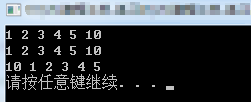
2. 容器类别:
序列式容器:排列次序取决于插入时机和位置
关联式容器:排列次序取决于特定准则
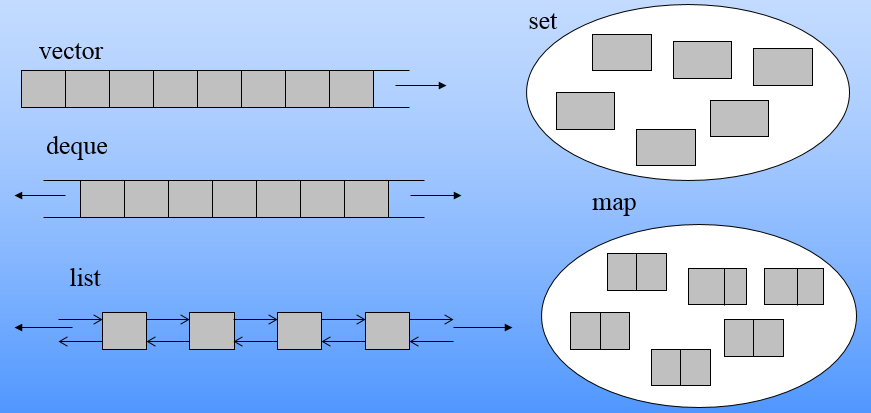
2.1 线性容器 ( array ):
#include <iostream> #include <array> #include <algorithm> using namespace std; //array容器在栈区,自动回收内存,不能增删查改, int main() { array<int, 10> MyArr{ 1,2,3,4,5,6,7,8,9,0 }; for (auto ib = MyArr.begin(), ie = MyArr.end(); ib != ie; ib++) { //cout << typeid(ib).name() << ": "; cout << *ib << " "; } cout << endl; for (auto i:MyArr) { cout << i << " "; } cout << endl; for_each(MyArr.begin(), MyArr.end(), [](int & x) {x += 1; }); for_each(MyArr.begin(), MyArr.end(), [](int x) {cout << x << " "; }); cout << endl; system("pause"); return 0; }

2.2 线性容器 ( vector ):
#include <iostream> #include <vector> #include <algorithm> using namespace std; //vector在堆区,可以增删查改, int main() { vector<int> MyVec{ 1,2,3,4,5,6,7,8,9,0 }; for (auto ib = MyVec.begin() + 3, ie = MyVec.end(); ib != ie; ib++) //vector迭带器可以+3 { cout << *ib << " "; } cout << endl; for (auto i : MyVec) { cout << i << " "; } cout << endl; for_each(MyVec.begin(), MyVec.end(), [](int & x) {x += 1; }); for_each(MyVec.begin(), MyVec.end(), [](int x) {cout << x << " "; }); cout << endl; system("pause"); return 0; }

2.3 线性容器 ( forwardlist ):单链表( forward:前进 )==>只能前进,不能后退
#include <iostream> #include <forward_list> //单链表(forward:前进)==>只能前进,不能后退 #include <algorithm> using namespace std; int main() { forward_list<int> my{ 1,2,3,4,5,6,7,8,9,0 }; for (auto ib = my.begin(), ie = my.end(); ib != ie; ib++) //ib++可以;但是ib--不行 { cout << *ib << " "; } cout << endl; for (auto i : my) { cout << i << " "; } cout << endl; for_each(my.begin(), my.end(), [](int & x) {x += 1; }); for_each(my.begin(), my.end(), [](int x) {cout << x << " "; }); cout << endl; system("pause"); return 0; }

2.4 线性容器 ( list ):双链表==>既可以前进,也可以后退
#include <iostream> #include <list> //双链表 #include <algorithm> using namespace std; int main() { list<int> my{ 1,2,3,4,5,6,7,8,9,0 }; for (auto ib = my.begin(), ie = my.end(); ib != ie; ib++) //ib++,ib--可以;但是ib+3不行 { cout << *ib << " "; } cout << endl; for (auto i : my) { cout << i << " "; } cout << endl; for_each(my.begin(), my.end(), [](int & x) {x += 1; }); for_each(my.begin(), my.end(), [](int x) {cout << x << " "; }); cout << endl; system("pause"); return 0; }

2.5 线性容器 (deque): 双端队列(分块) ==>性能综合的要求(增、删、查、改)
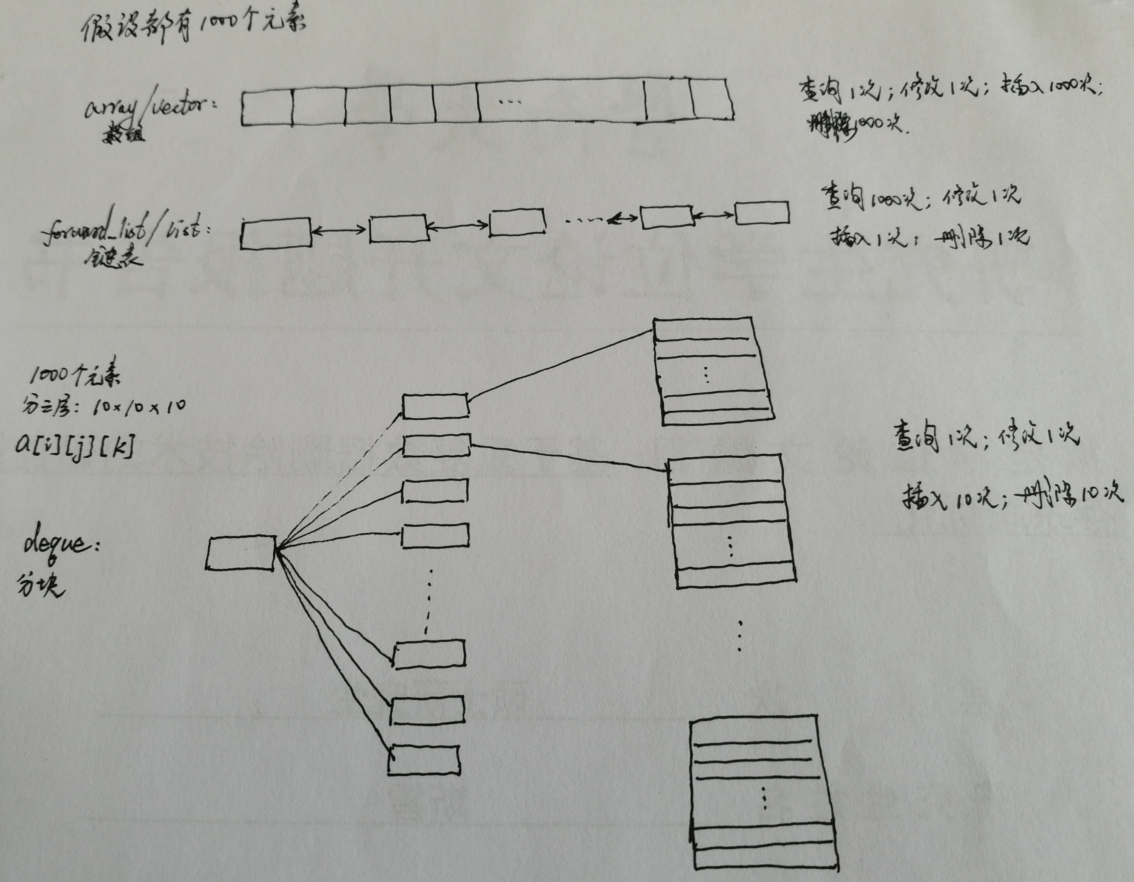
#include <iostream> #include <deque> //双端队列(分块数据模型),在堆上 #include <algorithm> using namespace std; int main() { deque<int> my{ 1,2,3,4,5,6,7,9 }; cout << "最大容量:" << my.max_size() << endl; //最大容量由内存决定 cout << "当前容量:" << my.size() << endl; cout << "第一个元素:" << my.front() << endl; cout << "最后一个元素:" << my.back() << endl; for (auto ib = my.begin(), ie = my.end(); ib != ie; ib++) { cout << *ib << " "; } cout << endl; for (auto i : my) { cout << i << " "; } cout << endl; for_each(my.begin(), my.end(), [](int & x) {x += 1; }); for_each(my.begin(), my.end(), [](int x) {cout << x << " "; }); cout << endl; system("pause"); return 0; }

deque的应用:
#include <iostream> #include <deque> //双端队列(分块数据模型),在堆上 #include <algorithm> using namespace std; int main() { deque<int> my{ 1,2,3,4,5,6,7,9 }; for_each(my.begin(), my.end(), [](int x) {cout << x << " "; }); cout << endl; my.push_back(10); //尾部插入数据10 for_each(my.begin(), my.end(), [](int x) {cout << x << " "; }); cout << endl; my.push_front(101); //头部插入 for_each(my.begin(), my.end(), [](int x) {cout << x << " "; }); cout << endl; my.insert(my.begin() + 5, 99); //任意位置插入 for_each(my.begin(), my.end(), [](int x) {cout << x << " "; }); cout << endl; my.pop_front(); //头部删除 my.pop_back(); //尾部删除 for_each(my.begin(), my.end(), [](int x) {cout << x << " "; }); cout << endl; my.erase(my.begin() + 4); //任意位置删除 for_each(my.begin(), my.end(), [](int x) {cout << x << " "; }); cout << endl; for (int i = 0; i < my.size(); i++) { cout << my[i] << " "; //可以用[]访问其中的元素,类模板中重载了[] } cout << endl; for (auto cb = my.cbegin(), ce = my.cend(); cb != ce; cb++) //cbegin(),cend()是常量迭代器;c表示const(只读) { cout << *cb << " "; //*cb = 1; //常量迭代器,只能读,不能写 } cout << endl; my.clear(); //清空 for_each(my.begin(), my.end(), [](int x) {cout << x << " "; }); cout << endl; system("pause"); return 0; }

2.6 线性容器 ( stack ): 栈
#include <iostream> #include <stack> //栈 #include <list> #include <vector> #include <algorithm> using namespace std; int main() { stack<int> myStack; //数组栈;stack默认底层是有deque实现的(因为deque的删除、插入性能也比较高) stack<int, list<int>> myListStack; //链式栈 stack<int, vector<int>> myVecStack; //可以任意指定底层的容器 myStack.push(1); myStack.push(2); myStack.push(3); myStack.push(4); myStack.push(5); while (!myStack.empty()) { cout << myStack.top() << endl; //打印栈顶元素 myStack.pop(); } system("pause"); return 0; }
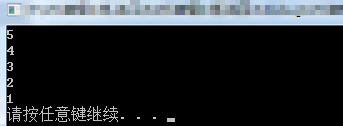
2.7 线性容器 ( queue): 队列
#include <iostream> #include <queue> //队列 #include <list> #include <vector> #include <algorithm> using namespace std; int main() { queue<int> myQ; //queue默认底层是deque实现的 queue<int, list<int>> myListQ; //指定底层容器为list queue<int, vector<int>> myVecQ; myQ.push(1); myQ.push(2); myQ.push(3); myQ.push(4); /* for (auto i : myQ) //队列不允许迭代器访问 { cout << i << " "; } cout << endl; */ while (!myQ.empty()) { cout << myQ.front() << endl; //打印栈顶元素 myQ.pop(); } system("pause"); return 0; }
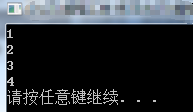
2.8 线性容器 ( string ): 字符串
#include <iostream> #include <string> #include <cstdlib> using namespace std; int main() { string str1 = "1234"; string str2 = "5678"; string str3 = str1 + str2; str3.push_back('X'); cout << str3 << endl; const char *p = str3.c_str(); //只能用只读指针const char *,返回内部指针 cout << p << endl; cout << *p << endl; for (auto i:str3) { cout << i << " "; } cout << endl; for (auto cb = str3.cbegin(), ce = str3.cend(); cb != ce; cb++) { cout << *cb << " "; } cout << endl; system("pause"); return 0; }

#include <iostream> #include <string> #include <cstdlib> using namespace std; int main() { string s1("12345hello hello hahaha"); s1.insert(s1.begin() + 3, 'X'); //任意位置插入字符 cout << s1 << endl; s1.erase(s1.begin() + 2, s1.begin() + 4); //删除从s1.begin() + 2到s1.begin() + 4的字符 cout << s1 << endl; s1.erase(1, 2); //删除从1开始的2个字符 cout << s1 << endl; s1.replace(0, 2, "world"); //从0位置开始,替换2个位置,替换内容为world cout << s1 << endl; s1.replace(s1.begin(), s1.begin()+5, "China"); cout << s1 << endl; s1.replace(5, 0, " haha "); //使用replace插入字符串 cout << s1 << endl; cout << s1.find("ha") << endl; //查找 cout << s1.find("ha",15) << endl; //指定位置开始查找 cout << s1.rfind("ha") << endl; //反向查找 cout << s1.find_first_of("1234a") << endl; //查找第一个属于"1234a"的字符 cout << s1.find_first_not_of("1234a") << endl; //第一个不属于的字符 cout << s1.length() << endl; //字符串的长度 cout << s1.size() << endl; //总共分配的长度 s1.empty(); //清空 cout << s1 << endl; cout << s1.length() << endl; system("pause"); return 0; }

3. 非线性容器:
3.1 优先队列( priority_queue ):
#include <iostream> #include <queue> #include <list> #include <vector> #include <algorithm> using namespace std; int main() { priority_queue<int> myQ; //优先队列 myQ.push(11); myQ.push(22); myQ.push(33); myQ.push(44); while (!myQ.empty()) { cout << myQ.top() << endl; //打印栈顶元素 myQ.pop(); } system("pause"); return 0; }
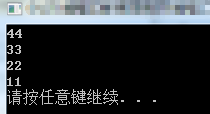
#include <iostream> #include <queue> #include <list> #include <vector> #include <algorithm> #include <cstring> using namespace std; struct getMoney { char *com; //公司 int money; //工资 }; struct lessX { bool operator ()(struct getMoney &m1, struct getMoney &m2) //伪函数 { //return m1.money < m2.money; //按money排序 if (strcmp(m1.com, m2.com) >= 0) //按com排序 return true; else return false; } }; int main() { priority_queue<getMoney,deque<getMoney>, lessX> myQ; //优先队列 getMoney getm[4] = { {"google",30},{"baidu",20},{"360",15},{"tencent",10} }; for (auto i:getm) { myQ.push(i); } while (!myQ.empty()) { cout << myQ.top().com << " " << myQ.top().money << endl; myQ.pop(); } system("pause"); return 0; }
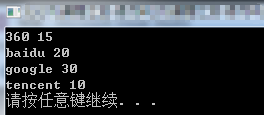
3.2 位处理容器( bitset ):
#include <iostream> #include <bitset> //处理位运算 #include <string> using namespace std; int main() { bitset<8> mybit(205); //1100 1101 8位 for (int i = 7; i >= 0; i--) //C++中 高字节在低位 ==>需要逆序打印 { cout << mybit[i]; if (i % 4 == 0) //每4位隔开,便于观察 { cout << " "; } } cout << endl; system("pause"); return 0; }

#include <iostream> #include <bitset> //处理位运算 #include <string> using namespace std; int main() { char ch = -1; bitset<8> mybit(ch); //8位 //1000 0001 原码 //1111 1110 反码 //1111 1111 补码 for (int i = 7; i >= 0; i--) //C++中 高字节在低位 ==>需要逆序打印 { cout << mybit[i]; if (i % 4 == 0) //每4位隔开,便于观察 { cout << " "; } } cout << endl; system("pause"); return 0; }

#include <iostream> #include <bitset> //处理位运算 #include <string> using namespace std; int main() { float fl = 19.875; cout << (void *)&fl << endl; //浮点数无法处理,只能处理整数,浮点数会转化为整数 bitset<32> mybit(fl); //32位 float占4字节 for (int i = 31; i >= 0; i--) //C++中 高字节在低位 ==>需要逆序打印 { cout << mybit[i]; if (i % 4 == 0) //每4位隔开,便于观察 { cout << " "; } } cout << endl; system("pause"); return 0; }

3.3 集合( set ):==>不允许重复的数据
#include <iostream> #include <set> //底层是红黑树,自动保证平衡,自动生成平衡查找二叉树 #include <cstdlib> using namespace std; int main() { set<int> myset{ 1,2,10,4,6 }; //set是用红黑树(会自动调整为平衡二叉查找树)实现的 myset.insert(16); myset.insert(15); myset.insert(15); //重复数据会被忽略 myset.erase(10); //直接删除 for (auto i:myset) { cout << i << " "; } cout << endl; for (auto ib = myset.begin(), ie = myset.end(); ib != ie; ib++) { cout << *ib << " "; } cout << endl; for (auto rb = myset.rbegin(), re = myset.rend(); rb != re; rb++) //反向迭代器 { cout << *rb << " "; } cout << endl; auto it = myset.find(15); //查找 if (it != myset.end()) { cout << "find " << *it << endl; } else { cout << "not find" << endl; } cout << myset.size() << endl; //元素个数 myset.empty() ; //清空 auto it1 = myset.find(15); //查找 if (it1 != myset.end()) { myset.erase(it1); //根据迭代器获取位置,删除 } for (auto i : myset) { cout << i << " "; } cout << endl; system("pause"); return 0; }

实现复杂数据类型自动排序:
#include <iostream> #include <set> //底层是红黑树,自动保证平衡,自动生成平衡查找二叉树 #include <cstdlib> #include <cstring> using namespace std; struct strless { bool operator()(const char *str1, const char *str2) //伪函数 { return (strcmp(str1, str2) < 0); } }; int main() { const char *p[] = { "calc","notepad","run","go","123" }; set<const char *, strless> myset(p, p + 5, strless()); //实现字符串的自动排序 myset.insert("245"); for (auto i:myset) { cout << i << " "; } cout << endl; system("pause"); return 0; }

3.4 多集合( multiset ):==>允许有重复数据
#include <iostream> #include <set> #include <cstdlib> #include <cstring> using namespace std; struct strless { bool operator()(const char *str1, const char *str2) //伪函数 { return (strcmp(str1, str2) < 0); } }; int main() { multiset<int> myset{ 1,2,3,3,3,4,4,5 }; //底层是红黑树,每个元素是一个链表 myset.insert(101); myset.insert(101); myset.insert(101); for (auto i:myset) { cout << i << " "; } cout << endl; auto it = myset.equal_range(3); //返回值是pair类型 pair<链表起点,链表终点> //cout << typeid(it).name() << endl; for (auto i = it.first; i != it.second; i++) { cout << *i << " "; } cout << endl; auto it1 = myset.find(101); //只查找链表的第一个元素 cout << "find: "<<*it1 << endl; /*实现复杂数据类型*/ const char *p[] = { "calc","notepad","run","go","go","go","123" }; multiset<const char *, strless> myset1(p, p + 7, strless()); //实现字符串的自动排序 myset1.insert("245"); for (auto i : myset1) { cout << i << " "; } cout << endl; system("pause"); return 0; }
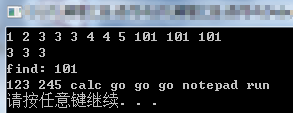
3.5 哈希表( hash_set ):已被unordered_set 替代
#define _SILENCE_STDEXT_HASH_DEPRECATION_WARNINGS //现在用新的容器unordered_set取代了hash_set,需要定义这个宏 #include <iostream> #include <hash_set> //底层是哈希表,是无序的 #include <cstring> using namespace std; struct strless { bool operator()(const char *str1, const char *str2) const //伪函数 { return (strcmp(str1, str2) == 0); //哈希表只能处理相等 } }; int main() { //哈希表,不需要考虑碰撞,查询的效率最高 hash_set<int> myset{ 1,19,2,18,3,17,4,16 }; myset.insert(29); for (auto i:myset) { cout << i << " "; } cout << endl; for (auto ib = myset.begin(), ie = myset.end(); ib != ie; ib++) { cout << *ib << " "; } cout << endl; for (auto rb = myset.rbegin(), re = myset.rend(); rb != re; rb++) //反向迭代器 { cout << *rb << " "; } cout << endl; cout << myset.size() << endl; //元素个数 cout << myset.bucket_count() << endl; //64是哈希表的大小 /*实现复杂数据类型*/ hash_set<const char *, hash_compare<const char *, strless>> hs; //hash_compare<const char *, strless>设定哈希函数,根据实际需求(string)设定哈希函数 hs.insert("apple"); hs.insert("google"); hs.insert("Microsoft"); hs.insert("oracle"); auto i = hs.find("google"); if (i != hs.end()) { cout << "find: " << *i << endl; //为什么输出apple呢??? } system("pause"); return 0; }

3.6 哈希表( unordered_set ):==>不允许重复数据
#include <iostream> #include <unordered_set> //凡是带unordered的容器底层都是哈希表实现,而不是红黑树 #include <string> using namespace std; int main() { unordered_set<string> myset{ "hello","world","move","jump","abc","last","one","sun","best" }; //unordered_set是无序的,按照哈希函数进行存放 myset.erase(myset.begin()); //删除哈希表的第一个 myset.erase("hello"); //精准删除 //myset.erase(myset.begin(), myset.end()); //删除某一段 for (auto i:myset) { cout << i << " "; } cout << endl; myset.insert("love"); //插入 for (auto ib = myset.begin(), ie = myset.end(); ib != ie; ib++) { cout << *ib << " "; } cout << endl; cout << "bucket_count:" << myset.bucket_count() << endl; //哈希表长度,自动增长,没有规律 cout << "max_size:" << myset.max_size() << endl; //最大大小 cout << "size:" << myset.size() << endl; //当前大小 for (int i = 0; i < myset.bucket_count(); i++) //打印整个哈希表(按bucket打印),可见unordered_set不允许重复, { //而unordered_multiset允许重复 cout << "bucket:" << i << ": "; for (auto it = myset.begin(i); it != myset.end(i); it++) { cout << " " << *it; } cout << endl; } system("pause"); return 0; }
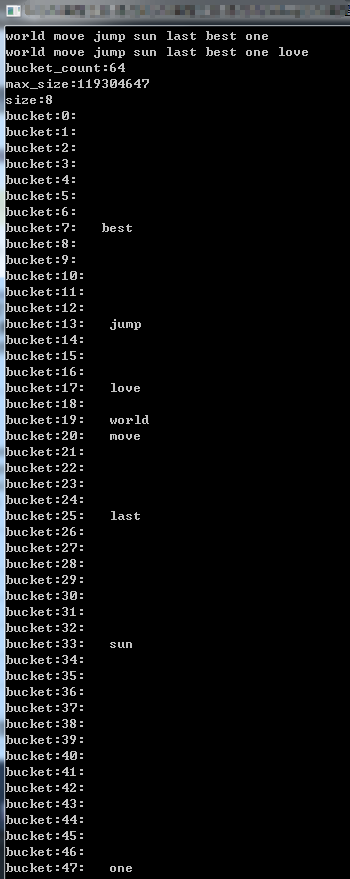
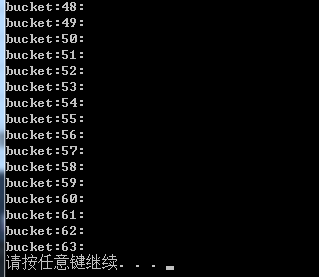
3.7 哈希表( unordered_multiset ):==>允许重复数据
#include <iostream> #include <unordered_set> #include <string> using namespace std; int main() { unordered_multiset<string> myset{ "pig","pig","pig","hen" }; myset.insert("love"); //插入 for (auto i:myset) { cout << i << endl; } cout << " "; auto it = myset.equal_range("pig"); while (it.first != it.second) //相同元素在链表上,起点为first,终点为second { cout << *it.first++ << endl; } system("pause"); return 0; }
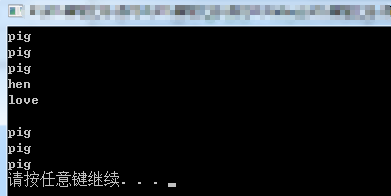
3.8 映射( map ) ==> 不允许重复 <==> 红黑树实现
#include <iostream> #include <map> //底层是红黑树 #include <cstring> using namespace std; //仿函数:STL六大组件之一 struct strless { bool operator()(const char *str1, const char *str2) { return (strcmp(str1, str2) < 0); //字符串对比 } }; int main() { map<char *, int> mymap; mymap.insert(pair<char *, int>("司令1", 10)); mymap.insert(pair<char *, int>("司令2", 11)); mymap.insert(pair<char *, int>("司令3", 13)); mymap.insert(pair<char *, int>("司令4", 12)); mymap.insert(pair<char *, int>("司令4", 1211)); //第一个字段,不允许有重复 for (auto i : mymap) { cout << i.first << " " << i.second << endl; } for (auto cb = mymap.cbegin(), ce = mymap.cend(); cb != ce; cb++) { cout << (*cb).first << " " << (*cb).second << endl; } auto it = mymap.find("司令2"); cout << "司令2: " << (*it).second << endl; /*map的排序实现*/ map<char *, int, strless> myMap; //根据strless仿函数来排序 myMap.insert(pair<char *, int>("a司令1", 10)); myMap.insert(pair<char *, int>("c司令2", 11)); myMap.insert(pair<char *, int>("d司令3", 13)); myMap.insert(pair<char *, int>("b司令4", 12)); myMap.erase("b司令4"); //删除 for (auto i : myMap) { cout << i.first << " " << i.second << endl; } auto ite = myMap.find("c司令2"); myMap.erase(ite,myMap.end()); //删除一段(从ite开始到end()) for (auto i : myMap) { cout << i.first << " " << i.second << endl; } auto it2 = myMap.begin()++; //红黑树,链式存储 //auto it2 = myMap.begin() + 3; //只能++,不能+3 cout << myMap["a司令1"] << endl; //可以通过下标[]来访问 //myMap.clear(); //清空 system("pause"); return 0; }
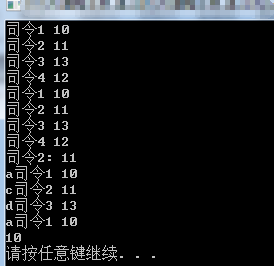
3.9 多映射( multimap ):==> 允许重复 <==> 红黑树实现
#include <iostream> #include <map> #include <cstring> using namespace std; struct strless { bool operator()(const char *str1, const char *str2) { return (strcmp(str1, str2) < 0); //字符串对比 } }; int main() { multimap<char *, int, strless> mymap; //multimap允许重复 加上strless仿函数后可以进行排序 mymap.insert(pair<char *, int>("司令1", 10)); mymap.insert(pair<char *, int>("司令4", 121)); mymap.insert(pair<char *, int>("司令4", 122)); mymap.insert(pair<char *, int>("司令2", 11)); mymap.insert(pair<char *, int>("司令3", 13)); mymap.insert(pair<char *, int>("司令4", 123)); mymap.insert(pair<char *, int>("司令4", 124)); for (auto i : mymap) { cout << i.first << " " << i.second << endl; } cout << endl; auto it = mymap.equal_range("司令4"); for (auto ib = it.first, ie = it.second; ib != ie; ib++) { cout << (*ib).first << " " << (*ib).second << endl; } cout << endl; system("pause"); return 0; }
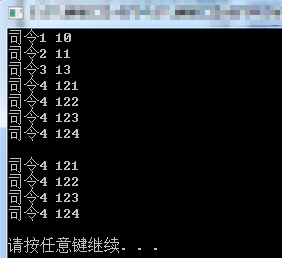
3.10 哈希映射( hash_map ):是unordered_map的前身
#define _SILENCE_STDEXT_HASH_DEPRECATION_WARNINGS #include <iostream> #include <hash_map> #include <string> using namespace std; //增删查改与map一样,本质是哈希表 int main() { hash_map<string, double> mymap{ { "good",120.32 },{ "better",150.89 },{ "best",218.56 },{ "hello",75.36 },{ "kitty",187.85 } }; mymap.insert(pair<string, double>("love", 356.71)); //插入 mymap.insert(hash_map<string, double>::value_type("like", 289.48)); //插入 for (auto i : mymap) { cout << i.first << " " << i.second << endl; } cout << endl; auto it = mymap.find("hello"); //查找 if (it != mymap.end()) { cout << it->second << endl; } /*显示哈希表*/ for (int i = 0; i < mymap.bucket_count(); i++) //打印整个哈希表(按bucket打印),可见unordered_set不允许重复, { //而unordered_multiset允许重复 cout << "bucket:" << i << ": "; for (auto it = mymap.begin(i); it != mymap.end(i); it++) { cout << " " << it->first << " " << it->second; } cout << endl; } system("pause"); return 0; }
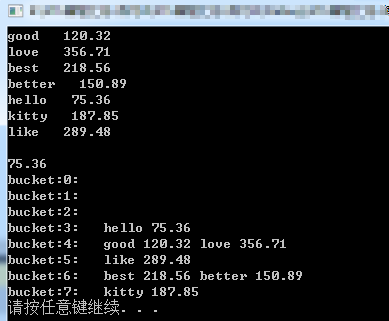
3.11 映射( unordered_map ):==> 不允许重复 <==> 哈希表实现
若要求综合性能,选:map
若要求最高查询性能,选:unordered_map
#include <iostream> #include <unordered_map> #include <string> using namespace std; //增删查改与map一样,本质是哈希表 int main() { unordered_map<string, double> mymap{ {"good",120.32},{"better",150.89},{"best",218.56},{"hello",75.36},{"kitty",187.85} }; mymap.insert(pair<string, double>("love", 356.71)); //插入 mymap.insert(unordered_map<string, double>::value_type("like",289.48)); //插入 for (auto i : mymap) { cout << i.first << " " << i.second << endl; } cout << endl; auto it = mymap.find("hello"); //查找 if (it != mymap.end()) { cout << it->second << endl; } /*显示哈希表*/ for (int i = 0; i < mymap.bucket_count(); i++) //打印整个哈希表(按bucket打印),可见unordered_set不允许重复, { //而unordered_multiset允许重复 cout << "bucket:" << i << ": "; for (auto it = mymap.begin(i); it != mymap.end(i); it++) { cout << " " << it->first<<" "<<it->second; } cout << endl; } system("pause"); return 0; }
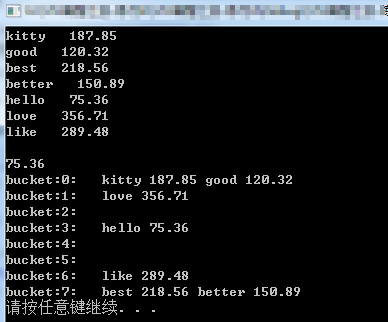
3.12 映射( unordered_multimap ):==> 允许重复 <==> 哈希表实现
#include <iostream> #include <unordered_map> #include <string> #include <algorithm> using namespace std; //增删查改与map一样,本质是哈希表,允许重复 int main() { unordered_multimap<string, double> mymap{ { "good",120.32 },{ "better",150.89 },{ "best",218.56 } }; mymap.insert(pair<string, double>("love", 356.71)); //插入 mymap.insert(pair<string, double>("love", 218.34)); mymap.insert(pair<string, double>("love", 568.45)); mymap.insert(unordered_map<string, double>::value_type("like", 289.48)); //插入 for (auto i : mymap) { cout << i.first << " " << i.second << endl; } cout << endl; auto it = mymap.find("hello"); //查找 if (it != mymap.end()) { cout << it->second << endl; } /*显示哈希表*/ for (int i = 0; i < mymap.bucket_count(); i++) //打印整个哈希表(按bucket打印),可见unordered_set不允许重复, { //而unordered_multiset允许重复 cout << "bucket:" << i << ": "; for (auto it = mymap.begin(i); it != mymap.end(i); it++) { cout << " " << it->first << " " << it->second; } cout << endl; } cout << endl; auto itx = mymap.equal_range("love"); for_each(itx.first, itx.second, [](unordered_multimap<string, double>::value_type &x) {cout << x.first << " " << x.second << endl; }); system("pause"); return 0; }

3.13 用于计算的 valarray:
#include <iostream> #include <valarray> //用于计算,计算的性能高于vector,array #include <iomanip> using namespace std; int main() { const double PI = 3.1415926535; valarray<double> val(9); for (int i = 0; i < 9; i++) { val[i] = PI*i*i; cout << val[i] << endl; } valarray<double> valx(9); for (int i = 0; i < 9; i++) { valx[i] = cos(i*PI / 3); //可以直接进行科学计算cos() cout << valx[i] << endl; } valarray<char *> my; //拥有数组的所有功能,长处是计算 system("pause"); return 0; }
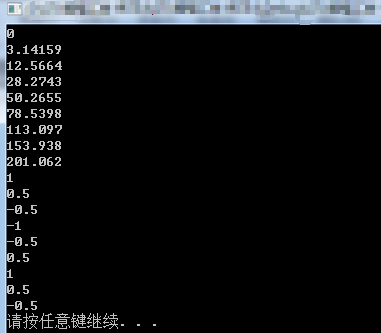
4. 容器小结:
